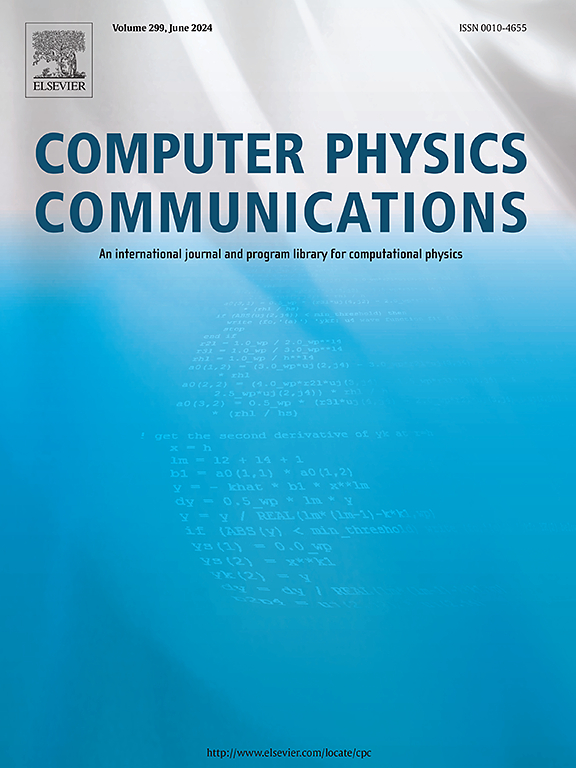NTVTOK-ML:基于机器学习方法的托卡马克中新古典环状粘滞力矩计算的快速代用模型
IF 7.2
2区 物理与天体物理
Q1 COMPUTER SCIENCE, INTERDISCIPLINARY APPLICATIONS
引用次数: 0
摘要
新古典环形粘度(NTV)扭矩是托卡马克环形动量的重要来源,对等离子体的不稳定性和性能有重大影响。NTV 扭矩的精确数值建模对于实验设计和运行以及深入了解相关物理过程至关重要。然而,NTV 扭矩计算耗时较长,这给其在实验分析和物理研究中的实际应用带来了挑战。在本研究中,我们开发了 NTVTOK-ML,这是一种用于 NTV 扭矩计算的替代模型,它结合了机器学习方法的表现力和快速推理能力,可同时实现准确性和时间效率。为了获得 NTV 扭矩的数据集,在实验性先进超导托卡马克(EAST)的各种等离子体条件下,使用 NTVTOK 和 MARS-F 代码进行了大量数值计算,涵盖了与实验相关的广泛参数范围,并纳入了丰富的物理效应,如俯仰角散射、全环形几何、共振等。对于固定磁扰动情况,NTVTOK-ML 分别采用了多层感知器(MLP)深度神经网络和极梯度提升(XGBoost)集合学习技术。此外,在考虑线性等离子体响应效应时,利用卷积神经网络(CNN)处理二维磁扰动数据。NTVTOK-ML 的预测精度基于统计指标进行评估,包括判定系数 (R2)、均方误差 (MSE) 和相对误差;单样本预测能力;以及泛化能力--证明了其在 NTV 扭矩预测任务中的可靠性。重要的是,与原始数字代码相比,使用我们提出的方法预测 NTV 扭矩所需的计算时间大幅减少了几个数量级。此外,NTVTOK-ML 框架提供的灵活性允许用户在特定情况下优化模型性能。总之,我们开发的方法为快速准确地预测 NTV 扭矩提供了一种简便易行的解决方案,同时纳入了重要的物理效应--从而促进了实验中的实时或间歇分析,以及全面的多尺度非线性时间演化建模:NTVTOK-MLCPC 程序库链接到程序文件:https://doi.org/10.17632/thcd9fbjd5.1Licensing provisions:Apache-2.0 编程语言:问题性质:托卡马克中 NTV 扭矩的传统数值计算非常耗时,这阻碍了实时或间隔实验分析和多尺度非线性时间演化建模。为了加快计算速度,对物理模型进行了简化;然而,这些简化往往会在某些参数范围内造成定量或定性偏差。因此,同时实现非线性时间演化建模的准确性和高效率,对于实验设计和操作以及全面了解相关物理过程至关重要:1.2. 进行大量 NTVTOK 和 MARS-F 计算,以构建包含各种物理效应(如俯仰角散射、全环形几何和共振)的 NTV 扭矩数据集; 3. 使用无量纲方法和对数变换对数据集进行预处理。对于二维磁扰动数据,采用 CNN 进行预处理;4.基于深度神经网络或集合学习方法开发和训练机器学习模型;5.从统计指标、单样本预测能力、泛化能力和计算效率等方面评估模型性能。结果表明,NTVTOK-ML 代用模型可在未来的研究中应用于各种物理任务。本文章由计算机程序翻译,如有差异,请以英文原文为准。
NTVTOK-ML: Fast surrogate model for neoclassical toroidal viscosity torque calculation in tokamaks based on machine learning methods
The Neoclassical Toroidal Viscosity (NTV) torque is a crucial source of toroidal momentum in tokamaks, exerting significant influence on plasma instability and performance. Accurate numerical modeling of NTV torque is essential for experimental design and operation, as well as for gaining insight into the relevant physical processes. However, the time-consuming nature of NTV torque calculation poses challenges for its practical application in experiment analysis and physical investigations. In this study, we have developed NTVTOK-ML, a surrogate model for NTV torque calculation that combines the expressive power and fast inference of machine learning methods to achieve simultaneous accuracy and time efficiency. To obtain datasets for NTV torque, extensive numerical calculations using NTVTOK and MARS-F codes were performed under various plasma conditions of Experimental Advanced Superconducting Tokamak (EAST), covering a wide range of experimentally relevant parameter regimes and incorporating rich physical effects such as pitch angle scattering, full toroidal geometry, resonances, etc. For fixed magnetic perturbation case, NTVTOK-ML employs Multi-Layer Perceptron (MLP) deep neural network and eXtreme Gradient Boosting (XGBoost) ensemble learning techniques respectively. Furthermore, when considering linear plasma response effect, Convolutional Neural Network (CNN) is utilized to process two-dimensional magnetic perturbation data. The prediction accuracy of NTVTOK-ML is evaluated based on statistical metrics including coefficient of determination (), mean squared error (MSE), and relative error; single sample prediction ability; and generalization ability - demonstrating its reliability in NTV torque prediction tasks. Importantly, the computational time required for predicting NTV torque using our proposed approach is significantly reduced compared to the original numerical code by several orders of magnitude. Additionally, the flexibility offered by the NTVTOK-ML framework allows users to optimize model performance under specific circumstances. Overall, our developed method provides an accessible solution for rapid yet accurate prediction of NTV torque while incorporating essential physical effects - thereby facilitating real-time or inter-shot analysis in experiments as well as comprehensive multi-scale nonlinear time evolution modeling.
Program summary
Program Title: NTVTOK-ML
CPC Library link to program files: https://doi.org/10.17632/thcd9fbjd5.1
Licensing provisions: Apache-2.0
Programming language: Python
Nature of problem: The traditional numerical calculation of NTV torque in tokamaks is time-consuming, which hinders real-time or inter-shot experimental analysis and multi-scale nonlinear time evolution modeling. Simplifications to physical models have been employed to accelerate the calculations; however, they often result in quantitative or qualitative deviations within certain parameter regimes. Therefore, achieving both accuracy and high time efficiency simultaneously for NTV modeling is essential for experiment design and operation, as well as a comprehensive understanding of relevant physical processes.
Solution method: 1. Generate a comprehensive plasma parameter space that encompasses a wide range of experimentally relevant tokamak plasma conditions; 2. Conduct numerous NTVTOK and MARS-F calculations to construct NTV torque datasets that incorporate various physical effects, such as pitch angle scattering, full toroidal geometry, and resonances; 3. Pre-process the datasets using dimensionless methods and logarithm transformation. For two-dimensional magnetic perturbation data, employ CNN for pre-processing; 4. Develop and train machine learning models based on deep neural networks or ensemble learning methods; 5. Evaluate the model performance in terms of statistical metrics, single sample prediction capability, generalization ability, and computational efficiency. The results indicate that the NTVTOK-ML surrogate model can be applied to diverse physical tasks in future studies.
求助全文
通过发布文献求助,成功后即可免费获取论文全文。
去求助
来源期刊

Computer Physics Communications
物理-计算机:跨学科应用
CiteScore
12.10
自引率
3.20%
发文量
287
审稿时长
5.3 months
期刊介绍:
The focus of CPC is on contemporary computational methods and techniques and their implementation, the effectiveness of which will normally be evidenced by the author(s) within the context of a substantive problem in physics. Within this setting CPC publishes two types of paper.
Computer Programs in Physics (CPiP)
These papers describe significant computer programs to be archived in the CPC Program Library which is held in the Mendeley Data repository. The submitted software must be covered by an approved open source licence. Papers and associated computer programs that address a problem of contemporary interest in physics that cannot be solved by current software are particularly encouraged.
Computational Physics Papers (CP)
These are research papers in, but are not limited to, the following themes across computational physics and related disciplines.
mathematical and numerical methods and algorithms;
computational models including those associated with the design, control and analysis of experiments; and
algebraic computation.
Each will normally include software implementation and performance details. The software implementation should, ideally, be available via GitHub, Zenodo or an institutional repository.In addition, research papers on the impact of advanced computer architecture and special purpose computers on computing in the physical sciences and software topics related to, and of importance in, the physical sciences may be considered.
 求助内容:
求助内容: 应助结果提醒方式:
应助结果提醒方式:


